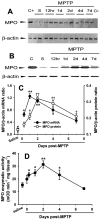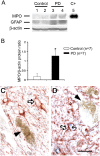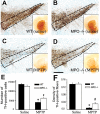Ablation of the inflammatory enzyme myeloperoxidase mitigates features of Parkinson's disease in mice
- PMID: 16014720
- PMCID: PMC6725426
- DOI: 10.1523/JNEUROSCI.0970-05.2005
Ablation of the inflammatory enzyme myeloperoxidase mitigates features of Parkinson's disease in mice
Abstract
Parkinson's disease (PD) is characterized by a loss of ventral midbrain dopaminergic neurons, which can be modeled by the neurotoxin 1-methyl-4-phenyl-1,2,3,6-tetrahydropyridine (MPTP). Inflammatory oxidants have emerged as key contributors to PD- and MPTP-related neurodegeneration. Here, we show that myeloperoxidase (MPO), a key oxidant-producing enzyme during inflammation, is upregulated in the ventral midbrain of human PD and MPTP mice. We also show that ventral midbrain dopaminergic neurons of mutant mice deficient in MPO are more resistant to MPTP-induced cytotoxicity than their wild-type littermates. Supporting the oxidative damaging role of MPO in this PD model are the demonstrations that MPO-specific biomarkers 3-chlorotyrosine and hypochlorous acid-modified proteins increase in the brains of MPTP-injected mice. This study demonstrates that MPO participates in the MPTP neurotoxic process and suggests that inhibitors of MPO may provide a protective benefit in PD.
Figures





Similar articles
-
NADPH oxidase mediates oxidative stress in the 1-methyl-4-phenyl-1,2,3,6-tetrahydropyridine model of Parkinson's disease.Proc Natl Acad Sci U S A. 2003 May 13;100(10):6145-50. doi: 10.1073/pnas.0937239100. Epub 2003 Apr 29. Proc Natl Acad Sci U S A. 2003. PMID: 12721370 Free PMC article.
-
Temporal mRNA profiles of inflammatory mediators in the murine 1-methyl-4-phenyl-1,2,3,6-tetrahydropyrimidine model of Parkinson's disease.Neuroscience. 2007 Mar 16;145(2):654-68. doi: 10.1016/j.neuroscience.2006.12.030. Epub 2007 Jan 29. Neuroscience. 2007. PMID: 17258864 Free PMC article.
-
Impaired CBS-H2S signaling axis contributes to MPTP-induced neurodegeneration in a mouse model of Parkinson's disease.Brain Behav Immun. 2018 Jan;67:77-90. doi: 10.1016/j.bbi.2017.07.159. Epub 2017 Aug 1. Brain Behav Immun. 2018. PMID: 28774789
-
[Myeloperoxidase in the neurodegenerative process of Parkinson's disease].Dtsch Med Wochenschr. 2014 Jan;139(3):99-102. doi: 10.1055/s-0033-1359907. Epub 2013 Nov 25. Dtsch Med Wochenschr. 2014. PMID: 24277448 Review. German.
-
Parkinson's disease.Int Rev Neurobiol. 2002;53:283-314. doi: 10.1016/s0074-7742(02)53011-7. Int Rev Neurobiol. 2002. PMID: 12512344 Review. No abstract available.
Cited by
-
Evaluation of nigrostriatal neurodegeneration and neuroinflammation following repeated intranasal 1-methyl-4-phenyl-1,2,3,6-tetrahydropyridine (MPTP) administration in mice, an experimental model of Parkinson's disease.Neurotox Res. 2014 Jan;25(1):24-32. doi: 10.1007/s12640-013-9401-8. Epub 2013 May 21. Neurotox Res. 2014. PMID: 23690159
-
The antioxidant role of thiocyanate in the pathogenesis of cystic fibrosis and other inflammation-related diseases.Proc Natl Acad Sci U S A. 2009 Dec 1;106(48):20515-9. doi: 10.1073/pnas.0911412106. Epub 2009 Nov 16. Proc Natl Acad Sci U S A. 2009. PMID: 19918082 Free PMC article.
-
An activatable PET imaging radioprobe is a dynamic reporter of myeloperoxidase activity in vivo.Proc Natl Acad Sci U S A. 2019 Jun 11;116(24):11966-11971. doi: 10.1073/pnas.1818434116. Epub 2019 May 23. Proc Natl Acad Sci U S A. 2019. PMID: 31123149 Free PMC article.
-
The organic cation transporter-3 is a pivotal modulator of neurodegeneration in the nigrostriatal dopaminergic pathway.Proc Natl Acad Sci U S A. 2009 May 12;106(19):8043-8. doi: 10.1073/pnas.0900358106. Epub 2009 Apr 29. Proc Natl Acad Sci U S A. 2009. PMID: 19416912 Free PMC article.
-
The endotoxin-induced neuroinflammation model of Parkinson's disease.Parkinsons Dis. 2011 Jan 18;2011:487450. doi: 10.4061/2011/487450. Parkinsons Dis. 2011. PMID: 21331154 Free PMC article.
References
-
- Andrews PC, Krinsky NI (1982) Quantitative determination of myeloperoxidase using tetramethylbenzidine as substrate. Anal Biochem 127: 346-350. - PubMed
-
- Brennan Jr WA, Bird ED, Aprille JR (1985) Regional mitochondrial respiratory activity in Huntington's disease brain. J Neurochem 44: 1948-1950. - PubMed
-
- Chen H, Zhang SM, Hernan MA, Schwarzschild MA, Willett WC, Colditz GA, Speizer FE, Ascherio A (2003) Nonsteroidal anti-inflammatory drugs and the risk of Parkinson disease. Arch Neurol 60: 1059-1064. - PubMed
-
- Dauer W, Przedborski S (2003) Parkinson's disease: mechanisms and models. Neuron 39: 889-909. - PubMed
Publication types
MeSH terms
Substances
Grants and funding
LinkOut - more resources
Full Text Sources
Other Literature Sources
Research Materials
Miscellaneous
